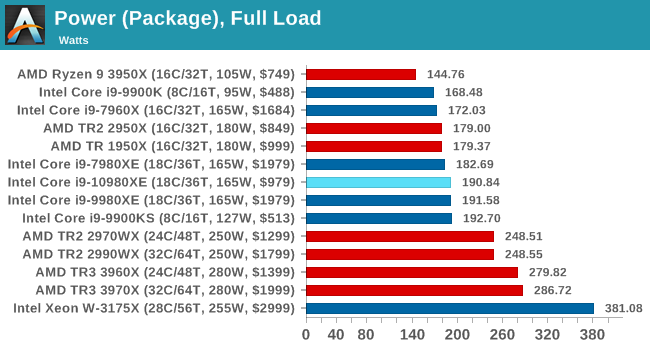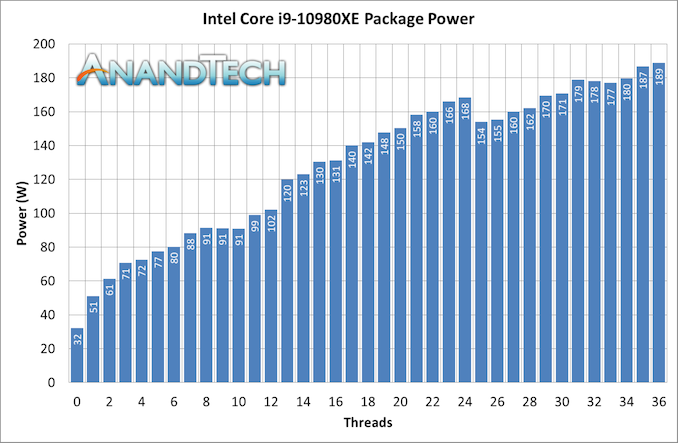It’s a Cascade of 14nm CPUs: AnandTech’s Intel Core i9-10980XE Review
by Dr. Ian Cutress on November 25, 2019 9:00 AM ESTPower Consumption
We’ve covered in detail across multiple articles the story of Intel’s turbo: about how the TDP on the box doesn’t mean a whole lot, the motherboard you’re using can ultimately determine how long your CPU does turbo for, and how the power limits of the processor are ultimately decided by the motherboard manufacturer’s settings in the BIOS unless you change them. Intel only gives recommendations on peak turbo power and the length of the turbo: the only thing Intel defines is the peak frequency based on load when turbo is allowed.
Talking Intel’s TDP and Turbo
Interviewing an Intel Fellow about TDP and Turbo
Comparing Turbo: AMD and Intel
This means that an extremely conservative system might not allow the power to go above TDP, but the system capable of all the power might allow the processor to turbo ad infinitum. The reality is usually somewhere in the middle, but for a high-end desktop platform, where most of the motherboards are engineered to withstand almost anything that comes at it, we’re going to often see the situation of an elongated or persistent turbo.
It’s worth noting that for consumer workloads, most of the work can happen within a reasonable turbo – and thus sustained performance metrics aren’t that important. But today we are testing high-end desktop hardware, and because Intel doesn’t explicitly define peak turbo power or turbo length (it only provides recommendations that motherboard manufacturers can and do ignore), I obviously asked Intel what it believes that reviewers should do when trying to compare performance. The answer wasn’t very helpful: test with a range of motherboards’.
In our previous review of the Core i9-9900KS, I did two sets of tests: benchmarks at the motherboard default, and tests at the Intel recommended turbo settings. The motherboard defaults, for that motherboard in question, were essentially full turbo all the time. Intel’s recommended settings gave some decreases in the long benchmarks, around 7%, but the rest of the tests were about the same.
For this review, we’re using ASRock’s X299 OC Formula motherboard. This is a motherboard designed for high-end and extreme overclocking, and is built accordingly. As a result, our sustained turbo and power limits are set very high. This is a HEDT system, and most HEDT motherboards are built and engineered this way, and so we expect our results here to be consummate with most users’ performance.
For our power consumption metrics, Intel actually does some obfuscation on its high-end platform. Unlike AMD, we cannot extract the per-core power numbers from the internal registers during a sustained workload. As a result, all we get are total package numbers, which show the cooling requirements of the processor but also include the power consumption of the DRAM controller, uncore, and PCIe root complexes.
The TDP of this chip is 165 W – normally Intel recommends a peak power of 1.25x, which would be 207 W, and so the 189 W value we see is under this. The chip we got is technically an engineering sample, not a retail part, although we usually expect the final stepping engineering samples to be identical to what is sold in the market. Despite this, your mileage may vary.
When we compare this peak to other CPUs:












79 Comments
View All Comments
Korguz - Thursday, November 28, 2019 - link
yep.. i knew gondalf wouldnt answer my question...0ldman79 - Thursday, December 5, 2019 - link
That is ignorant.Adding L3 cannot increase processing. The L3 can only improve feeding of data, further the L3 is a victim cache, the data has to be expelled from the L2 first.
It doesn't matter how big the fuel line is on your 4 cylinder, it's only going to burn so much gas. Same for the L2 and L3. If the size of the cache increases the IPC that is *only* because the cache was too small for the design in the first place.
Korguz - Sunday, December 8, 2019 - link
keep in mind, the comment is from gondalf, he will say any thing to make his beloved intel look better, as you can see, he DIDN'T answer my question to him as well...airdrifting - Monday, November 25, 2019 - link
You are delusional. 2011 is the year for 2500K/2600K release, and since then Intel has been charging 300+ for quad core till 2017 Ryzen release. It was also the six darkest years in CPU history where we see like 5% increase in IPC every year, I kept my 4.5GHz overclocked 2600K for 6 years because there was no reason to upgrade.eek2121 - Monday, November 25, 2019 - link
Yeah that was part of the issue. Sandy Bridge had so much overclocking headroom, you could put a good AiO on it, crank it up to 4.8-5.0 GHz, and generations later the competition would just barely catch up. The percentage of difference between the two was very small, and Bulldozer was chasing Core i3s.rahvin - Monday, November 25, 2019 - link
You're not alone buddy. I've held on to my Icy Bridge 3700K until Ryzen 39**X because Intel was offering no innnovation to the market.I distinctly remember the Anandtech article for IIRC the Kaby Lake Intel processors where they basically said this was the first generation to be 20% better than Sandy Bridge/Icy Bridge which made is worth upgrading. That was 6 years without any performance increases.
Make no mistake, without AMD competition we wouldn't have moved beyond 8 cores on the desktop or 12 cores in the HEDT. Intel was happy to sit on their fingers and rake in the money with 2-5% improvement per year. In fact 3 solid years of AMD competition have doubled core counts on both the desktop and server and at the same time lowered prices across the board. Without AMD there is no innovation at Intel because they don't have competition. Thank god for Lisa Su.
Santoval - Monday, November 25, 2019 - link
Bollocks. Pulling arbitrary dollar values of nameless CPUs out of your behinds and linking even more arbitrarily 2011 CPUs to 2019 CPUs is an extremely poor tactic. Your suck at this (-->Intel apologetics). Be better so we can have meaningful arguments :)milkywayer - Monday, November 25, 2019 - link
Read the article your posting spam at. The author mentions the 1900 and 900 numbers. I'll let you guess which page. You might actual read the review then.milkywayer - Monday, November 25, 2019 - link
Whups. Meant it for RegsEx.milkywayer - Monday, November 25, 2019 - link
Out of the kindness of their heart. How generous and kind of them./s